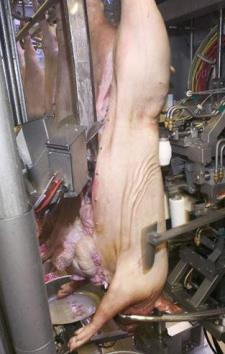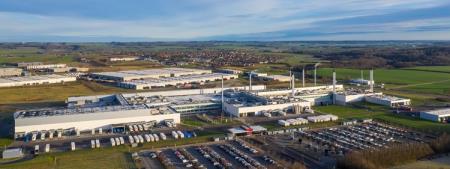 A recent article in Wired by Eve Sneider documented the low prevalence rate of COVID-19 among workers at the Danish Crown hog plant in Horsens, Denmark. Less than ten workers have tested positive for SARS-CoV-2 among 8,000 employees in all Danish Crown facilities. There have been no interruptions in processing, and production rates were maintained throughout the first quarter.
A recent article in Wired by Eve Sneider documented the low prevalence rate of COVID-19 among workers at the Danish Crown hog plant in Horsens, Denmark. Less than ten workers have tested positive for SARS-CoV-2 among 8,000 employees in all Danish Crown facilities. There have been no interruptions in processing, and production rates were maintained throughout the first quarter.
 Management attributes the low infection rate both in their plants and in the surrounding communities to early lockdown and to the extensive use of robotics and mechanization in processing. The Horsens plant is the most modern in the world using infrared laser-guided robots to make cuts including the critical “tail cut” that extirpates the terminal intestinal tract to avoid fecal contamination. A series of laser and machine-vision guided robots continues dismemberment, completing the tasks that would otherwise be carried out by workers, allowing the plant to processes 18,000 hogs per eight-hour shift.
Management attributes the low infection rate both in their plants and in the surrounding communities to early lockdown and to the extensive use of robotics and mechanization in processing. The Horsens plant is the most modern in the world using infrared laser-guided robots to make cuts including the critical “tail cut” that extirpates the terminal intestinal tract to avoid fecal contamination. A series of laser and machine-vision guided robots continues dismemberment, completing the tasks that would otherwise be carried out by workers, allowing the plant to processes 18,000 hogs per eight-hour shift.
It is inevitable that robotics will have to be incorporated into processing lines in U.S. plants placing less reliance on workers and allowing appropriate distancing. Both in the red meat and chicken industries, considerable capital will be required to replace manual workers. Events over the past three months have demonstrated the vulnerability of packing plants to reduced labor availability. Plants are the fragile link in the supply chain extending from farms to retail.
COVID-19 spreads rapidly within plants given the proximity of workers in both first processing and deboning. Modern EU chicken plants and those erected in Eastern Europe and the Middle East during the past decade incorporate mechanization, robotics and advanced processing technology compared to U.S. facilities located in southern states. Design of U.S. plants and their equipment is predicated on the availability of relatively inexpensive labor. European producers do not have the luxury of an infinite supply of workers even though temporary immigrant labor is used in some nations.
 The capital investment required to mechanize processing will have to be passed on to consumers. Given the disruptions in supply during March and April with depleted supermarket cases, consumers will have to accept increases in price to ensure a steady supply of wholesome meat products.
The capital investment required to mechanize processing will have to be passed on to consumers. Given the disruptions in supply during March and April with depleted supermarket cases, consumers will have to accept increases in price to ensure a steady supply of wholesome meat products.
An added justification for mechanization and the installation of robots is the reality that packing plants are a source of infection for local communities. This is clearly demonstrated by prevalence rates in rural counties where a large plant is located. Workers in plants equipped with advanced mechanical installations will have appropriate skills, commanding higher wage rates that will be reflected in more acceptable accommodation obviating domestic overcrowding. This factor contributes to relatively high prevalence rates in communities attributed to infection acquired and spread among low-paid immigrant workers performing repetitive manual labor.
It is axiomatic that robots are refractory to disease, do not take holidays or sick leave, never participate in strikes or agitate to join unions and have immense physical strength and dexterity compared to human labor. It is unfortunate that it has taken COVID-19 to force a re-evaluation of the human component and available alternatives in meat processing. COVID-19 will not be the last viral pandemic and this reality should evoke changes taking us beyond The Jungle of Upton Sinclair.